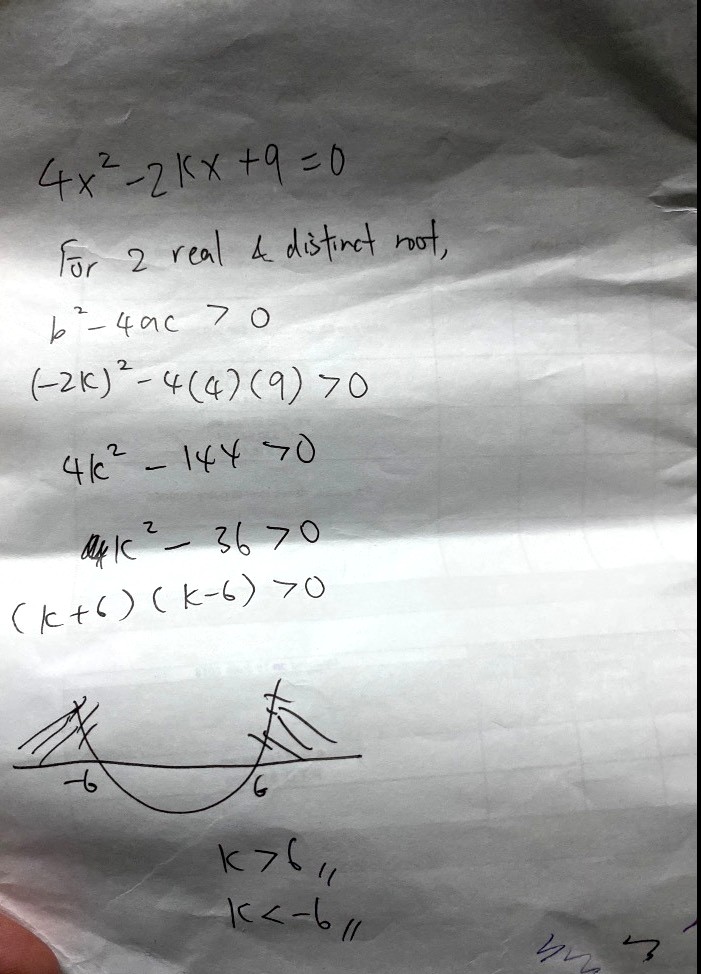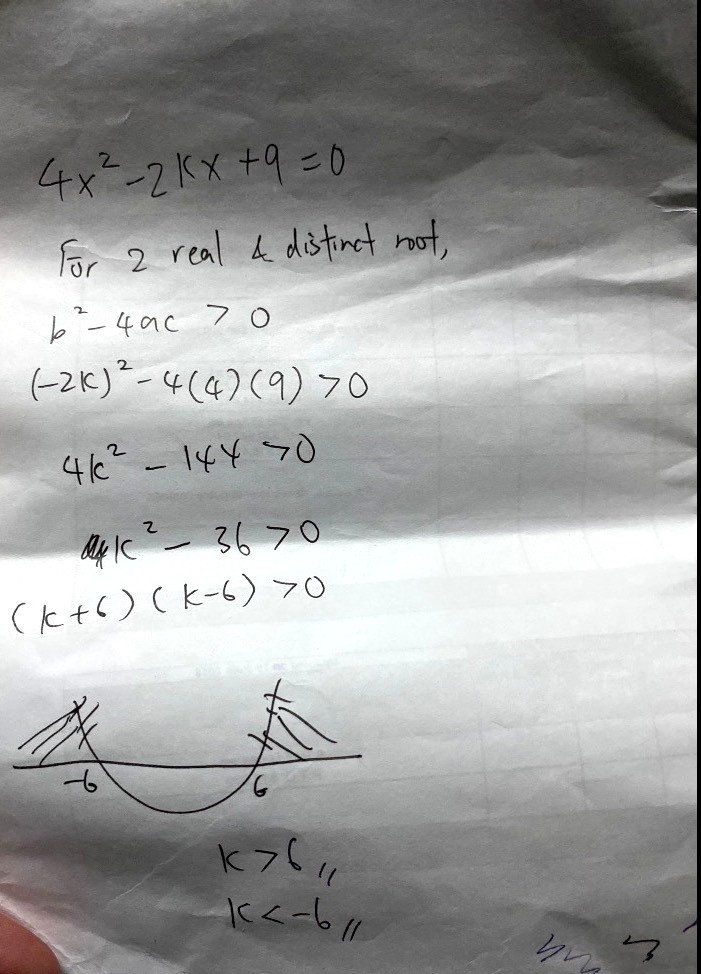Ask Singapore Homework?
Upload a photo of a Singapore homework and someone will email you the solution for free.

Question
junior college 2 | H1 Maths
2 Answers Below
Anyone can contribute an answer, even non-tutors.

Need help
For two distinct roots, discriminant > 0
For a quadratic equation ax² + bx + c = 0,
Discriminant = b² - 4ac
So (-2k)² - 4(4)(9) > 0
4k² - 144 > 0
k² - 36 > 0
(k + 6)(k - 6) > 0
k² - 36 is a upward sloping parabola
(u-shaped)
The intersection points with the y-axis are
k = 6 and k = -6.
The region between k = 6 and k = -6 is negative.
Since we want k² - 36 > 0 we want the positive region
i.e k< -6 or k > 6
The highest power of x is 2. So the max number of roots is 2 also.
For example ,
x² + 6x + 9 = 0
x² + 2(3)(x) + 3² = 0
(x + 3)² = 0
(x + 3)(x + 3) = 0
x = 3 or x = 3
For such cases, b² - 4ac = 0
(i.e the roots are in the form of complex numbers, where terms like i are used.
i = √-1, which is non-real. stands for imaginary)
Likewise, i² = -1
For a quadratic equation ax² + bx + c = 0,
x² + (b/a) x + c/a = 0
x² + 2(b/2a) x + (b/2a)² + c/a = (b/2a)²
(x + b/2a)² + c/a = (b/2a)²
(x + b/2a)² = b²/4a² - c/a
(x + b/2a)² = (b² - 4ac)/4a²
x + b/2a = ±√((b² - 4ac)/4a²)
x + b/2a = ± √(b² - 4ac) / 2a
x = -b/2a ± √(b² - 4ac) / 2a
x = (-b ± √(b² - 4ac) ) / 2a
This is the famous quadratic formula.
① When b² - 4ac > 0, the term inside the square root is positive.
So we can get a real number. and the ± means there are 2 unique real solutions /real roots to the equation.
② When b² - 4ac = 0, square root of 0 is still 0.
So x = (-b±0) / 2a = -b/2a
There is only one real solution/root.
③ When b² - 4ac < 0, the inside of the square root is negative.
There are no real solutions/real roots to the equation. The solutions are what we called complex numbers (a combo of real and imaginary numbers)
x² + 2x + 3 = 0
Here a = 1, b = 2 , c = 3
Using quadratic formula,
x = [ -2 ± √(2² - 4(1)(3) ) ] / 2(1)
x = [-2 ± √-8] / 2
x = -1 ± √-8 / 2
x = -1 ± √((4)(2)(-1)) / 2
x = -1 ± √4√2√-1 / 2
x = -1 ± 2√2√-1 / 2
x = -1 ± √2√-1
Typically at O level we will stop here and say that there are no real roots to the equation, since a square root of a negative number means it is non-real.
x² + 2x + 3 = 0
x² + 2x + 1 + 2 = 0
(x + 1)² + 2 = 0
(x + 1)² = -2
x + 1 = ± √-2
x = -1 ± √-2
At O level we will stop here and say there are no real roots/solutions to the equation.
BUT, at H2 Math in A levels (perhaps not applicable to H1) ,
x = -1 ± √-2
x = -1 ± √((2)(-1))
x = -1 ± √2 √-1
x = -1 ± √2 i
(b² - 4ac is the formula. Discriminant is the name)
Then you can say that there are no real roots/solutions to the equation.
See 2 Answers






